Chapter 4: Managing change
Key points
- Managing change well is critical to the success of any reform, policy, or service implementation.
- Most agencies (87 per cent) have identified the need to improve their change management capability.
- Communication from the SES to employees has a significant impact on perceptions of change management.
- Less than half of respondents to the 2018 APS employee census agreed that communication between the SES and employees was effective.
- Positive perceptions of change management are associated with higher engagement from employees, better employee wellbeing, and perceptions of better performance of an employee’s workgroup and agency.
The management of change has been identified as a critical variable for the success or failure of any reform34 yet worldwide, organisations struggle with successfully implementing change. Research from Gartner shows that on average organisations have experienced five major changes in the past three years, of which only 34 per cent were successful.35 A recent report from the McKinsey Center for Government noted that the failure rate of government transformations, at 80 per cent, is far too high.36
A strong change management culture is required for the APS to effectively address future reform, and as such, there is a need to ensure the underlying processes are in place to build this culture. This includes ensuring that leaders have the capability to drive change. This is no easy task. Leading and managing change was identified as an area for further development in the capability review programs, with some agencies failing to deliver on formal change initiatives due to issues such as poor upfront planning and lack of effective communication.37,38
The APS is not alone in this regard. United Kingdom (UK) civil service capability reviews and annual employee satisfaction surveys have also identified leading and managing change as a systemic weakness.39, 40
Subsequent to these capability review findings, agency self-assessments of their change management capability have shown that more work is needed. In the 2017 APS agency survey, Most agencies (87 per cent) self-assessed that they needed to increase their change management capability. Forty-five per cent reported that since 2015 their change management capability had declined.
Employees also agreed that change management was not strong in agencies. Just over a third of respondents to the 2018 APS employee census agreed that change is managed well in their agency. There has been a slight positive increase in perceptions since 2013 (Figure 18). These figures align with those seen in worldwide public sectors (37 per cent), including in the UK (35 per cent).41
Figure 18: APS employee perceptions of whether change is managed well in their agency, 2013–18
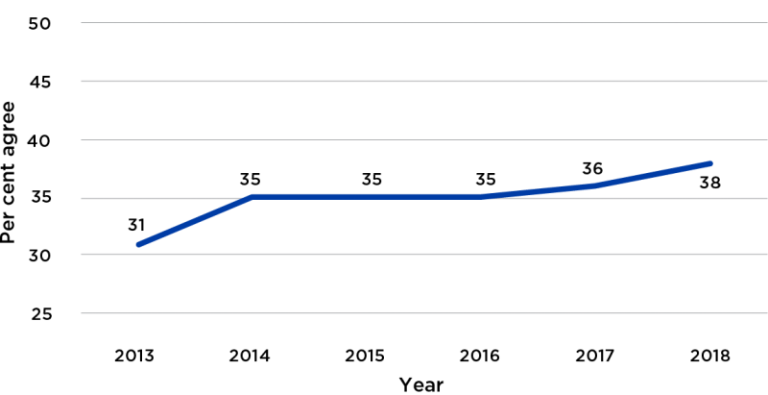
Source: APS employee census
One lesson learned from the experience of OECD countries on managing change was the importance of effective communication .42 Results from the 2018 APS employee census also show that positive perceptions of change management are significantly associated with internal communication. When internal communication is effective, respondents perceive that change is being well managed. Figure 19 shows that more than 80 per cent of employees who agree change is managed well also agree that internal communication is effective.
Figure 19: APS employee perceptions of effective internal communication by perceptions of effective change management
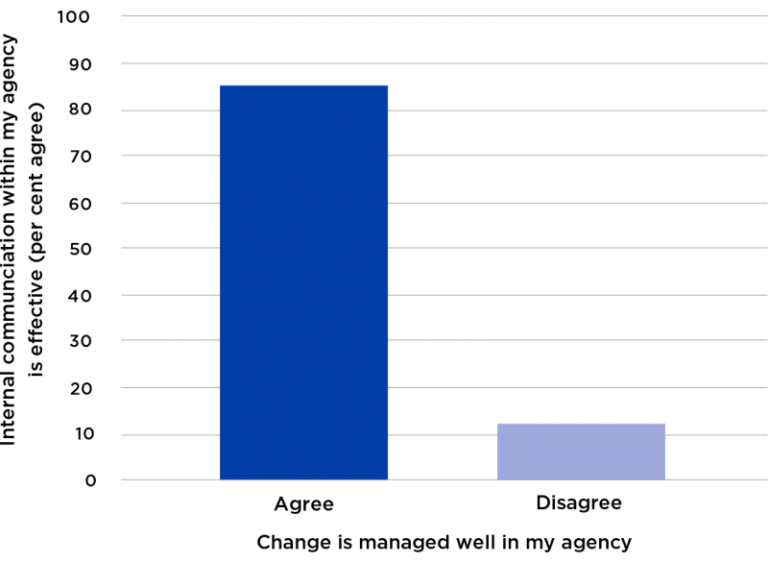
Source: 2018 APS employee census
Communication is important from all levels of the organisation, from immediate supervisor through to SES. Analysis shows that communication from SES to employees has the most significant impact on perceptions of change management. Less than half of respondents to the 2018 APS employee census agreed that communication between SES and employees was effective (Figure 20). This is an area of focus for improvement and, as discussed in Chapter 10 Developing Leadership, agencies are undertaking various approaches to build leadership capability.
Figure 20: APS employee perceptions of effectiveness of communication from SES to employees, 2016–18

Source: APS employee census
Senior leaders perceived to communicate well with employees may be consulting more about change and informing employees of the purpose, intent and progress of change in their agency. As a result, employees may then perceive their agency is managing change well. Figure 21 displays the relationship between perceptions of change management and effectiveness of communication from SES. More than 70 per cent of employees who agree that change is managed well in their agency also agree that communication between SES and other employees is effective.
Figure 21: APS employee perceptions of communication between the SES and other employees by perceptions of effective change management
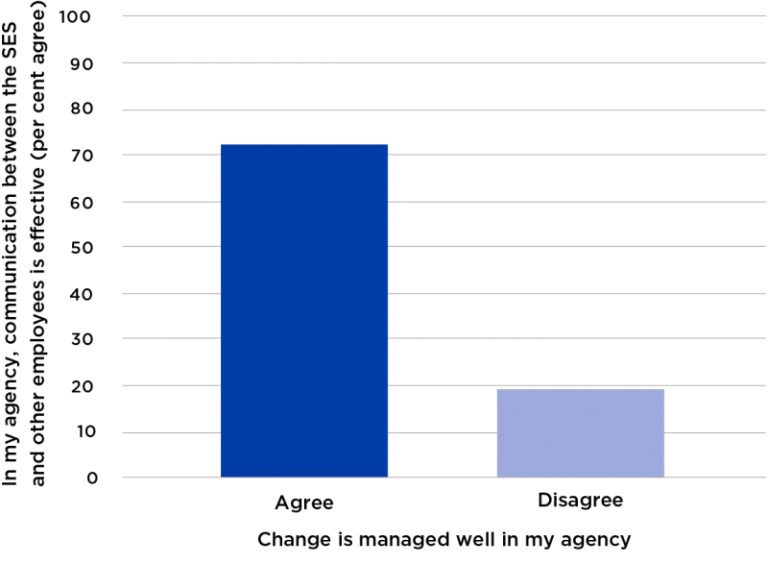
Source: 2018 APS employee census
For change to be successful, employees need to be consulted during the change process. This ensures clarity of purpose and direction, and engagement from all levels. Those not consulted report that change is not being managed well (Figure 22).
Figure 22: APS employee perceptions of whether they are consulted about change at work by perceptions of effective change management
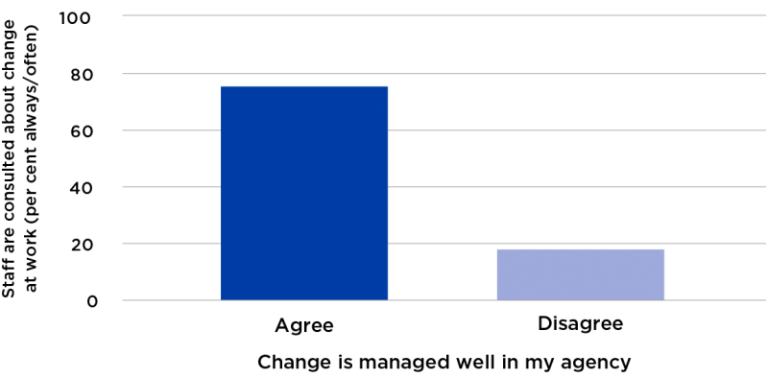
Source: 2018 APS employee census
Many costs are associated with poor change management. At the broader level, this includes failed reform, ineffective policies and inefficient services. In the workplace, employees within agencies where change is not being managed well, feel they have more unrealistic time pressures, less autonomy in decision making, poor clarity with their roles and responsibilities, and more strained relationships with colleagues (Figure 23).
The capability review program highlighted that organisational culture can be one of the greatest barriers to successful change management in the APS. Addressing these workplace stressors will enable change and improve workplace culture.
Figure 23: APS employee perceptions of effective change management by workplace
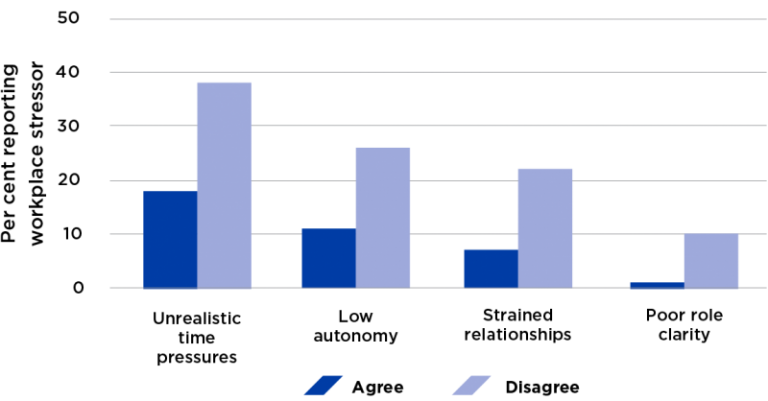
Source: 2018 APS employee census
Many positive benefits are associated with managing change well. Results from the 2018 APS employee census showed that positive perceptions of change management were associated with higher engagement from employees, better employee wellbeing, and perceptions of better performance of an employee’s workgroup and agency. Figure 24 shows that employees who perceived their agency managed change well, also rated highly their agency’s success in meeting goals and objectives.
Figure 24: APS employee perceptions of effective change management by ratings of agency performance
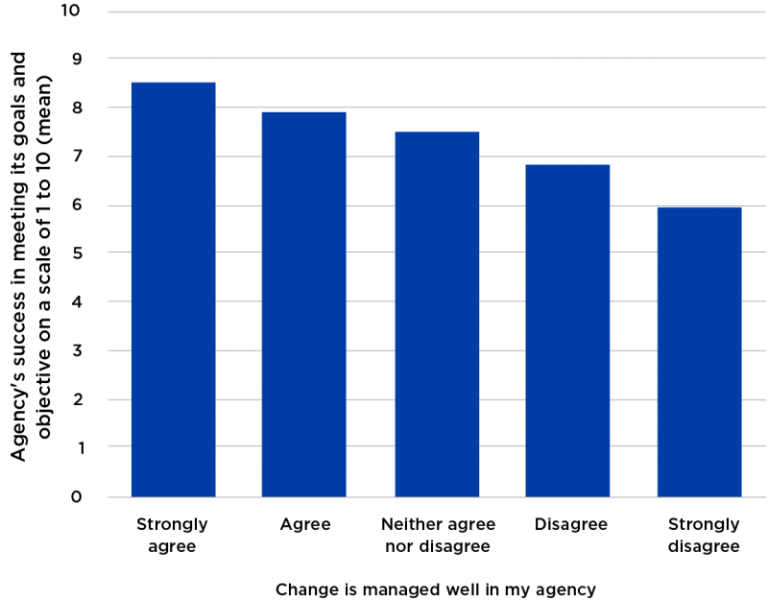
Source: 2018 APS employee census
Many agencies have identified the need to improve their change management capability. International research shows this is not an easy task. Focusing on the underlying processes of building a strong change culture will prepare the APS for the challenges ahead. Various strategies to develop leadership capability will be discussed in Chapter 10 Developing Leadership.
34 Huerta Melchor, O (2008), ‘Managing Change in OECD Governments: An Introductory Framework’, OECD Working Papers on Public Governance, no. 12, OECD publishing.
35 CEB (2018), ‘Open source change: Making Change Management Work’. Presentation delivered to the APSC on 26 September 2018.
36 McKinsey Center for Government (2018), ‘Delivering for citizens: How to triple the success rate of government transformations’, https://www.mckinsey.com/~/media/McKinsey/Industries/Public%20Sector/Ou… (accessed 15 October 2018).
37 Capability Review Program, conducted by the APSC between 2012 and 2015, assessed the capabilities of agencies to meet future objectives and challenges. Further information is contained in the glossary of the report.
38 APSC, State of the Service Report 2011–12.
39 UK Civil Service (2014), The Capabilities Plan: 2014 Annual Refresh, Civil Service Reform.
40 Cabinet Office (2017), Civil Service People Survey: 2017 results, Civil Service benchmark results.
41 ORC International Perspectives (2018).
42 Huerta Melchor, O (2008), ‘Managing Change in OECD Governments: An Introductory Framework’, OECD Working Papers on Public Governance, no. 12, OECD publishing.



